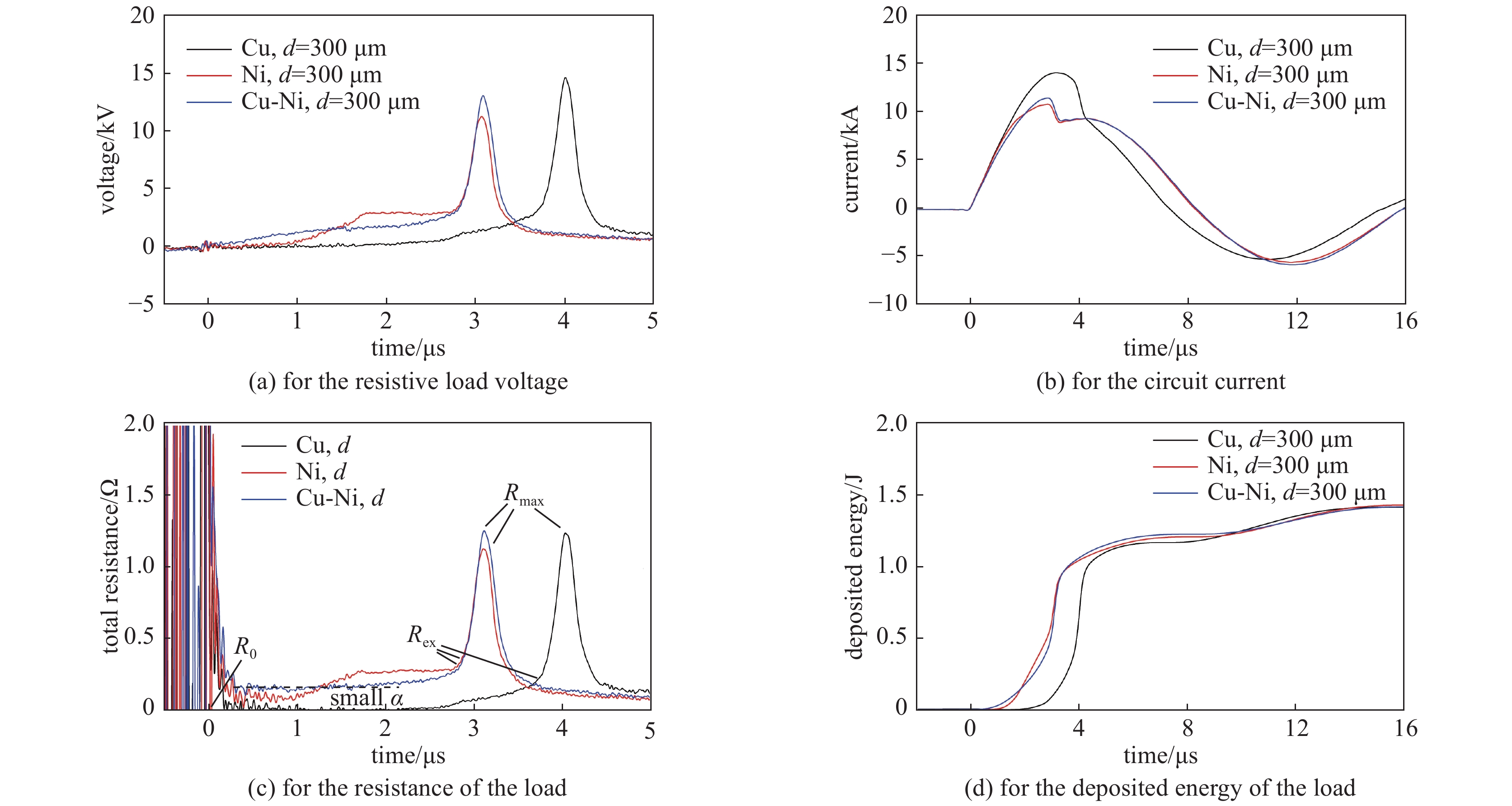Discharge characteristics and spatial-temporal evolution of Cu-Ni alloy wire explosion
-
摘要: 脉冲电流驱动金属丝电爆炸可产生具有较高能量密度的等离子体,并伴随脉冲电磁辐射、强冲击波等效应,广泛应用于Z箍缩、电热化学武器、油气助采等领域;与纯金属相比,合金具备电阻率高、成分可调、相变复杂等特点,在电爆炸效应参数的调控方面具有很大潜力。开展了大气空气介质中铜、镍、铜镍(康铜)丝在微秒时间尺度电脉冲作用下电爆炸实验研究,通过放电参数与自辐射图像诊断,获取电爆炸过程放电参数与时空演变的特性规律,得到脉冲电流作用下合金电爆炸在相变与等离子体方面的特征。实验发现,在电爆炸早期,铜镍合金的高电阻率能够提高能量沉积效率:铜52%、镍74%、铜镍合金78%;而相爆开始后,合金丝负载则更接近纯镍丝负载性能。等离子体通道早期膨胀速率在5 mm/μs量级,随后迅速衰减;合金丝等离子体膨胀时间更久,击穿后平均电阻率上升缓慢,且等离子体辐射与金属爆炸产物在空间尺度上存在关联性。特别地,铜镍合金气溶胶分层同时具有横向和纵向特征(特征尺度10−1 mm),但整体较铜气溶胶更为均匀。Abstract: Electrical explosion of wires (EEW) driven by pulse current can produce plasmas with high energy density, and is accompanied by electromagnetic pulses, strong shock waves, etc., therefore it is widely adopted in Z-pinch, electrothermal chemical weapons, oil and gas exploitation and other fields. Compared to pure metal, alloy has characteristics of the high resistivity, adjustable composition, and complex phase transitions. It has great potential in regulating parameters of EEW. This paper presents an experimental study on exploding Cu, Ni, and Cu-Ni alloy (constantan) wires in atmospheric air under a microsecond time-scale pulsed current. Through the diagnoses of electrical parameters and self-emission images, the discharge characteristics and spatial-temporal evolution of explosion products were obtained. Features of the alloy wire explosion in phase transition and plasma were acquired as well. Experiments revealed that in the early stage of EEW, the high resistivity of the alloy could improve the energy deposition efficiency, namely 52% for Cu, 74% for Ni, and 78% for Cu-Ni, while after the explosion, performance of the alloy wire was closer to that of the Ni wire. The initial expansion rate of the plasma channel reached 5 mm/μs level but then decayed. The expansion process of alloy wire endured longer, and the average resistivity went up slowly after the breakdown. Also, a correlation was found between plasma radiation and metal aerosol in spatial scale. Especially, the alloy aerosol has crossed striation features (10−1 mm), but it is more uniform than Cu aerosol generally.
-
表 1 放电参数结果统计
Table 1. Statistics of the discharge parameters above
wire type initial calculated
resistance R0/Ωmaximum measured
resistance Rmax/Ωmaximum electric
power Pmax/MWenergy to vaporize
the wire Ev/Jdeposited
energy Ed/Joverheating
factor ξtotal deposited
energy Etotal/J300-μm Cu 5.01×10−3 1.30±0.02 166.0±3.5 78.23 56.2±1.3 ~0.72 117.4±1.6 300-μm Ni 2.21×10−2 1.15±0.01 113.3±3.1 106.67 59.6±0.5 ~0.56 121.6±1.7 300-μm Cu-Ni 1.35×10−1 1.28±0.02 135.2±0.4 89.26 56.8±1.5 ~0.64 120.3±1.3 -
[1] Chace W G, Moore H K. Exploding wires[M]. New York: Plenum Press, 1959. [2] 张永民, 姚伟博, 邱爱慈, 等. 金属丝电爆炸现象研究综述[J]. 高电压技术, 2019, 45(8):2668-2680. (Zhang Yongmin, Yao Weibo, Qiu Aici, et al. Review of wire electrical explosion phenomena[J]. High Voltage Engineering, 2019, 45(8): 2668-2680 [3] 邱爱慈. 脉冲功率技术应用[M]. 西安: 陕西科学技术出版社, 2016.Qiu Aici. Pulsed power technology applications[M]. Xi’an: Shaanxi Science and Technology Press, 2016). [4] 高翔, 万元熙, 丁宁, 等. 可控核聚变科学技术前沿问题和进展[J]. 中国工程科学, 2018, 20(3):25-31. (Gao Xiang, Wan Yuanxi, Ding Ning, et al. Frontier issues and progress of controlled nuclear fusion science and technology[J]. Strategic Study of CAE, 2018, 20(3): 25-31 [5] 王莹, 孙元章, 阮江军, 等. 脉冲功率科学与技术[M]. 汕头: 汕头大学出版社, 2010.Wang Ying, Sun Yuanzhang, Run Jiangjun, et al. Science and technology on pulsed power[M]. Shantou: Shantou University Press, 2010). [6] 王俞卫, 陈冬群, 张自成, 等. 基于爆磁压缩发生器的紧凑脉冲功率源(英文)[J]. 强激光与粒子束, 2019, 31:025002. (Wang Yuwei, Chen Dongqun, Zhang Zicheng, et al. Compact pulsed power source based on explosively driven magnetic flux compression generator[J]. High Power Laser and Particle Beams, 2019, 31: 025002 doi: 10.11884/HPLPB201931.180242 [7] 王坤, 姜林村, 史宗谦, 等. 纳秒级铝单丝电爆炸过程中金属态-非金属态转变研究[J]. 中国电机工程学报, 2021, 41(8):2957-2964. (Wang Kun, Jiang Lincun, Shi Zongqian, et al. Metal-nonmetal transition in nanosecond electrical explosion of aluminum wires[J]. Proceedings of the CSEE, 2021, 41(8): 2957-2964 [8] Pikuz S A, Sinars D B, Shelkovenko T A, et al. High energy density z-pinch plasma conditions with picosecond time resolution[J]. Physical Review Letters, 2002, 89: 035003. doi: 10.1103/PhysRevLett.89.035003 [9] Ouyang Peixuan, Li Peijie, Leksina E G, et al. Effect of liquid properties on laser ablation of aluminum and titanium alloys[J]. Applied Surface Science, 2016, 360: 880-888. doi: 10.1016/j.apsusc.2015.11.080 [10] Liao Qilong, Tannenbaum R, Wang Zhonglin. Synthesis of FeNi3 alloyed nanoparticles by hydrothermal reduction[J]. The Journal of Physical Chemistry B, 2006, 110(29): 14262-14265. doi: 10.1021/jp0625154 [11] Chace W G. Liquid behavior of exploding wires[J]. The Physics of Fluids, 1959, 2(2): 230-235. doi: 10.1063/1.1705912 [12] Han Ruoyu, Wu Jiawei, Qiu Aici, et al. A platform for exploding wires in different media[J]. Review of Scientific Instruments, 2017, 88: 103504. doi: 10.1063/1.4996027 [13] Tucker T J, Toth R P. EBW1: a computer code for the prediction of the behavior of electrical circuits containing exploding wire elements[R]. Albuquerque: USDOE, 1975. [14] Burtsev V A, Kalinin N V, Luchinski A V. Electrical explosion of conductors and its application in electro-physical installations[M]. Moscow: Energoatomizdat, 1990. [15] Tkachenko S I, Pikuz S A, Romanova V M, et al. Overvoltage pulse development upon electrical explosion of thin wires[J]. Journal of Physics D: Applied Physics, 2007, 40(6): 1742-1750. doi: 10.1088/0022-3727/40/6/022 [16] Bigelmayr M, Pieterse P, Uhrlandt D. Energy dissipation and efficiency of exploding stainless steel wires of various lengths and diameters[J]. Journal of Physics D: Applied Physics, 2020, 54: 045202. [17] Zhao Junping, Xu Zhuo, Yan Wenyu, et al. Characteristics and diffusion of electrical explosion plasma of aluminum wire in argon gas[J]. IEEE Transactions on Plasma Science, 2017, 45(2): 185-192. doi: 10.1109/TPS.2017.2651032 [18] Han Ruoyu, Zhu Wanying, Wu Jiawei, et al. Spatial–temporal evolution of plasma radiation in electrical wire explosion: a morphological observation[J]. Journal of Physics D: Applied Physics, 2020, 53: 345201. doi: 10.1088/1361-6463/ab8b07 -





 下载:
下载:







